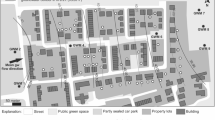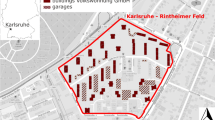Abstract
Shallow geothermal applications have become standard solutions for heating and cooling in many newly built or redeveloped residential neighborhoods, but current urban development practices do not yet consider the new demands that result from the intensive thermal use of the shallow subsurface. A coordinated site characterization is of great importance as a sound basis for an optimized planning of geothermal systems that brings together user requirements (heating, cooling, and/or seasonal energy storage) and (hydro)geological subsurface conditions. The aim of this study is to raise awareness and to demonstrate the relevance of a coordinated site characterization. Therefore, this study quantifies the advantages of a site-specific over a desktop-based site characterization in reducing uncertainty for calculation of borehole heat exchanger length and predicted induced temperature changes in the subsurface for a newly developed residential neighborhood in the city of Taucha, Germany. Results show that savings of over EUR 1850 per house (EUR 98,050 for the entire neighborhood) can be achieved by a coordinated exploration and prediction accuracy of temperature plume development was substantially improved. Although being more cost intensive, exploration costs for this case study are <3% of the assumed individual geothermal system costs of EUR 16,000 if divided equally among geothermal users. Three different options are presented to implement coordinated exploration concepts into site development practice.









Similar content being viewed by others
References
Bayer P, Saner D, Bolay S, Rybach L, Blum P (2012) Greenhouse gas emission savings of ground source heat pump systems in Europe: a review. Renew Sustain Energy Rev 16:1256–1267. doi:10.1016/j.rser.2011.09.027
Beck FP, Clark PJ, Puls RW (2000) Location and characterization of subsurface anomalies using a soil conductivity probe. Ground Water Monit Remediat 20:55–59. doi:10.1111/j.1745-6592.2000.tb00265.x
Butler JJ (1997) The design, performance, and analysis of slug tests. CRC Press, Boca Raton
Butler JJ (2002) A simple correction for slug tests in small-diameter wells. Ground Water 40:303–308. doi:10.1111/j.1745-6584.2002.tb02658.x
Butler JJ (2005) Hydrogeological methods for estimation of spatial variations in hydraulic conductivity. In: Rubin Y, Hubbard SS (eds) Hydrogeophysics. Springer, Dordrecht, pp 23–58
Butler JJ, Garnett EJ (2000) Simple procedures for analysis of slug tests in formations of high hydraulic conductivity using spreadsheet and scientific graphics software. In: Kansas Geological Survey Open File Report 2000-40
Chiasson AD, Rees SJ, Spitler JD (2000) A preliminary assessment of the effects of groundwater flow on closed-loop ground source heat pump systems. ASHRAE Trans 106:380–393
Christy CD, Christy TM, Wittig A (1994) A percussion probing tool for the direct sensing of soil conductivity. Report of Geoprobe Systems. Salina, Kansas
Dehkordi SE, Schincariol RA (2014) Effect of thermal-hydrogeological and borehole heat exchanger properties on performance and impact of vertical closed-loop geothermal heat pump systems. Hydrogeol J 22:189–203. doi:10.1007/s10040-013-1060-6
Decagon Devices (2011) KD2 pro thermal properties analyzer operator’s manual. Decagon Devices Inc., Pullmann
DHI-WASY (2013) FEFLOW 6.2 Finite element subsurface flow and transport simulation system—user manual, Berlin. http://www.mikepoweredbydhi.com/-/media/shared%20content/mike%20by%20dhi/flyers%20and%20pdf/product-documentation/feflow%206.2%20user%20manual.pdf. letzter Zugriff 27 May 2015
Di Sipio E, Chiesa S, Destro E, Galgaro A, Giaretta A, Gola G, Manzella A (2013) Rock thermal conductivity as key parameter for geothermal numerical models. Energy Procedia 40:87–94. doi:10.1016/j.egypro.2013.08.011
Diao N, Li Q, Fang Z (2004) Heat transfer in ground heat exchangers with groundwater advection. Int J Therm Sci 43:1203–1211. doi:10.1016/j.ijthermalsci.2004.04.009
Diersch H-JG, Bauer D, Heidemann W, Rühaak W, Schätzl P (2011a) Finite element modeling of borehole heat exchanger systems: part 1. Fundamentals. Comput Geosci 37:1122–1135. doi:10.1016/j.cageo.2010.08.003
Diersch H-JG, Bauer D, Heidemann W, Rühaak W, Schätzl P (2011b) Finite element modeling of borehole heat exchanger systems: part 2. Numer Simul Comput Geosci 37:1136–1147. doi:10.1016/j.cageo.2010.08.002
Dietrich P, Leven C (2006) Direct push-technologies. In: Kirsch R (ed) Groundwater geophysics. Springer, Berlin, pp 321–340
Dietrich P, Butler JJ, Faiß K (2008) A rapid method for hydraulic profiling in unconsolidated formations. Ground Water 46:323–328. doi:10.1111/j.1745-6584.2007.00377.x
DWD - Deutscher Wetterdienst (2014) Vorläufige Gradtagzahlen für ausgewählte Orte in Deutschland: http://www.dwd.de/bvbw/generator/DWDWWW/Content/Oeffentlichkeit/KU/KU1/KU12/Klimadaten/Gradtagzahl/Archiv/Gesamt__2013__3807,templateId=raw,property=publicationFile.pdf/Gesamt_2013_3807.pdf. Accessed 07 Aug 2014
Eissmann L (1975) Das Quartär der Leipziger Tieflandsbucht und angrenzender Gebiete um Saale und Elbe. Akademie-Verlag, Berlin
EPA (1997) Field analytical and Site Characterization Technologies. Summary of Applications. U.S. EPA, Washington D.C., p 19
Epting J, Haendel F, Huggenberger P (2013) Thermal management of an unconsolidated shallow urban groundwater body. Hydrol Earth Syst Sci 17:1851–1869. doi:10.5194/hess-17-1851-2013
Erol S, François B (2014) Efficiency of various grouting materials for borehole heat exchangers. Appl Therm Eng 70:788–799. doi:10.1016/j.applthermaleng.2014.05.034
Eskilson P (1987) Dissertation: thermal analysis of heat extraction boreholes. University of Lund, Schweden, Lund
European Commission (2014) Annex paper: CiTIEs—Cities of Tomorrow Investigation in Europe
Florides G, Kalogirou S (2007) Ground heat exchangers—a review of systems, models and applications. Renew Energy 32:2461–2478. doi:10.1016/j.renene.2006.12.014
Florides GA, Pouloupatis PD, Kalogirou S, Messaritis V, Panayides I, Zomeni Z, Partasides G, Lizides A, Sophocleous E, Koutsoumpas K (2011) The geothermal characteristics of the ground and the potential of using ground coupled heat pumps in Cyprus. Energy 36:5027–5036. doi:10.1016/j.energy.2011.05.048
García-Gil A, Vázquez-Suñé E, Sánchez-Navarro JÁ, Mateo Lázaro J (2015) Recovery of energetically overexploited urban aquifers using surface water. J Hydrol 531, Part 3:602–611. doi:10.1016/j.jhydrol.2015.10.067
Hähnlein D-GS, Molina-Giraldo D-IN, Blum DP, Bayer DP, Grathwohl PDP (2010) Ausbreitung von Kältefahnen im Grundwasser bei Erdwärmesonden. Grundwasser 15:123–133. doi:10.1007/s00767-009-0125-x
Hähnlein S, Bayer P, Ferguson G, Blum P (2013) Sustainability and policy for the thermal use of shallow geothermal energy. Energy Policy 59:914–925
Hähnlein S, Blum P, Bayer P (2011) Oberflächennahe Geothermie – aktuelle rechtliche Situation in Deutschland. Grundwasser 16:69–75. doi:10.1007/s00767-011-0162-0
Heidinger G, Dornstädter J, Fabritius A, Welter M, Wahl G (2004) Zurek: EGRT—enhanced geothermal response test. In: Proceedings 8. Geothermische Fachtagung, Landau, pp 316–323
Hein P, Kolditz O, Görke U-J, Bucher A, Shao H (2016) A numerical study on the sustainability and efficiency of borehole heat exchanger coupled ground source heat pump systems. Appl Therm Eng 100:421–433
Hoffmann R, Dietrich P (2004) An approach to determine equivalent solutions to the geoelectrical 2D inversion problem. J Appl Geophys 56:79–91. doi:10.1016/j.jappgeo.2004.03.005
Hoffmann S, Atkinson T, Polom U, Werban U, Leven C, Engeser B (2008) Integrierter Einsatz von Scherwellenseismik und Direct-Push-Verfahren zur Erkundung eines urbanen Grundwasserleiters. Grundwasser 13:78–90. doi:10.1007/s00767-008-0067-8
Hölting B, Coldewey W (2013) Hydrogeologie: Einführung in die Allgemeine und Angewandte Hydrogeologie. Elsevier, München
Indacoechea-Vega I, Pascual-Muñoz P, Castro-Fresno D, Calzada-Pérez MA (2015) Experimental characterization and performance evaluation of geothermal grouting materials subjected to heating–cooling cycles. Constr Build Mater 98:583–592. doi:10.1016/j.conbuildmat.2015.08.132
Kinzelbach W, Rausch R (1995) Grundwassermodellierung: Eine Einführung mit Übungen. Gebrüder Borntraeger Verlag, Berlin
Knödel K, Krummel H, Lange G (1997) Geophysik - Handbuch der Erkundung des Untergrundes von Deponien und Altlasten. Springer, Berlin
Lessoff SC, Schneidewind U, Leven C, Blum P, Dietrich P, Dagan G (2010) Spatial characterization of the hydraulic conductivity using direct-push injection logging. Water Resour Res. doi:10.1029/2009wr008949
LfULG - Sächsisches Landesamt für Umwelt und Geologie, 1996. Geologische Karte der eiszeitlich bedeckten Gebiete von Sachsen (Maßstab 1:50000). Freiberg
LfULG (2013) Geothermisches Kartenwerk im Maßstab 1:50000 GTK 50, Karte der Entzugsleistungen - Allgemeine Erläuterungen
LfULG - Sächsisches Landesamt für Umwelt und Geologie, 2014. Geologische Aufschlüsse in Sachsen. http://www.umwelt.sachsen.de/umwelt/infosysteme/weboffice101/synserver?project=geologie-bohrungen&language=de&view=bohrungen. Accessed 12 May 2014
LfULG - Sächsisches Landesamt für Umwelt und Geologie, 2015. Interaktive Karten und Kartenübersichten in Sachsen. http://www.umwelt.sachsen.de/umwelt/infosysteme/weboffice101/synserver?project=wasser-grundwasser&language=de&view=grundwasser. Accessed 04 Aug 2015
Lo Russo S, Taddia G, Verda V (2012) Development of the thermally affected zone (TAZ) around a groundwater heat pump (GWHP) system: a sensitivity analysis. Geothermics 43:66–74. doi:10.1016/j.geothermics.2012.02.001
Luo J, Rohn J, Xiang W, Bayer M, Priess A, Wilkmann L, Steger H, Zorn R (2015) Experimental investigation of a borehole field by enhanced geothermal response test and numerical analysis of performance of the borehole heat exchangers. Energy 84:473–484. doi:10.1016/j.energy.2015.03.013
McCall W, Nielsen DM, Farrington SP, Christy TM (2006) Use of direct-push technologies in environmental site characterization and ground-water monitoring. In: Nielsen DM (ed) Practical handbook of environmental site characterization and ground-water monitoring. CRC Press, Boca Raton, pp 345–471
Müller B, Hausmann J, Niedzwiedz H (2008) Vorschläge für einheitliche, geotechnische Klassifikationen von Festgesteinen und Festgebirgen für das Bauwesen sowie den Bergbau. In: Schriftreihe Geotechnik, vol 2. Presented at the 2. Fachtagung Geotechnik, Dresden, pp 91–127
Pannike S, Kölling M, Schulz HD, Panteleit B, Reichling J, Scheps V (2006) Auswirkung hydrogeologischer Kenngrößen auf die Kältefahnen von Erdwärmesondenanlagen in Lockersedimenten. Grundwasser 11:6–18. doi:10.1007/s00767-006-0114-2
Panteleit, 2016. Personal communication
Panteleit DB, Reichling DJ (2006) Automatisierte Attribuierung von Bohrungsdaten mit Parametern zur Optimierung von Erdwärmesondenanlagen. Grundwasser 11:19–26. doi:10.1007/s00767-006-0115-1
Raymond J, Therrien R, Gosselin L, Lefebvre R (2011) Numerical analysis of thermal response tests with a groundwater flow and heat transfer model. Renew Energy 36:315–324. doi:10.1016/j.renene.2010.06.044
Rücker C, Günther T, Spitzer K (2006) Three-dimensional modelling and inversion of dc resistivity data incorporating topography—I. Modelling. Geophys J Int 166(2):495–505
Sanner B, Karytsas C, Mendrinos D, Rybach L (2003) Current status of ground source heat pumps and underground thermal energy storage in Europe. Geothermics 32:579–588. doi:10.1016/S0375-6505(03)00060-9
Sanner B, Hellström G, Spitler J, Gehlin S (2005) Thermal response test—current status and world-wide application. In: Proceedings of the world geothermal congress 2005, 24–29 April. Antalya, Turkey
Schulmeister MK, Butler JJ, Healey JM, Zheng L, Wysocki DA, McCall GW (2003) Direct-push electrical conductivity logging for high-resolution hydrostratigraphic characterization. Ground Water Monit Remediat 23:52–62. doi:10.1111/j.1745-6592.2003.tb00683.x
Seibertz KSO, Chirila MA, Bumberger J, Dietrich P, Vienken T (2016) Development of in-aquifer heat testing for high resolution subsurface thermal-storage capability characterisation. J Hydrol 534:113–123. doi:10.1016/j.jhydrol.2015.12.013
Sellwood SM, Healey JM, Birk S, Butler JJ (2005) Direct-push hydrostratigraphic profiling: coupling electrical logging and slug tests. Ground Water 43:19–29. doi:10.1111/j.1745-6584.2005.tb02282.x
Staatsbetrieb Geoinformation und Vermessung Sachsen (GeoSN) (2015). Karte der mittleren Grundwasserflurabstände in Sachsen. Geoportal Sachsen. http://www.revosax.sachsen.de/Details.do?sid=2942414717472. letzter Zugriff am 14 Oct 2015
Tinti F, Bruno R, Focaccia S (2015) Thermal response test for shallow geothermal applications: a probabilistic analysis approach. Geotherm Energy 3:6. doi:10.1186/s40517-015-0025-5
Vandenbohede A, Hermans T, Nguyen F, Lebbe L (2011) Shallow heat injection and storage experiment: heat transport simulation and sensitivity analysis. J Hydrol 409:262–272. doi:10.1016/j.jhydrol.2011.08.024
VDI 4640-1 (ed) (2010) Thermal use of the underground: fundamentals, approvals, environmental aspects
Vienken T, Reboulet E, Leven C, Kreck M, Zschornack L, Dietrich P (2013) Field comparison of selected methods for vertical soil water content profiling. J Hydrol 501:205–212. doi:10.1016/j.jhydrol.2013.08.004
Vienken T, Kreck M, Hausmann J, Werban U, Dietrich P (2014) Innovative strategies for high resolution site characterization: application to a flood plain. Acque Sotter Ital J Groundw 3:7–14. doi:10.7343/AS-091-14-0118
Vienken T, Schelenz S, Rink K, Dietrich P (2015) Sustainable intensive thermal use of the shallow subsurface—a critical view on the status quo. Groundwater 53:356–361. doi:10.1111/gwat.12206
Werban U, Leven C (2007) Technologies for a fast characterization of subsurface structures—an example from the Milan-Rho site. Ital J Eng Geol Environ 1:115–122. doi:10.4408/IJEGE.2007-01.S-17
Zhu K, Blum P, Ferguson G, Balke K-D, Bayer P (2010) The geothermal potential of urban heat islands. Environ Res Lett. doi:10.1088/1748-9326/5/4/044002
Zlotnik VA, McGuire VL (1998) Multi-level slug tests in highly permeable formations: 1. Modification of the Springer-Gelhar (SG) model. J Hydrol 204:271–282. doi:10.1016/S0022-1694(97)00128-5
Acknowledgements
This study was funded by the German Ministry of Education and Research (Bundesministerium für Bildung und Forschung) in the course of the joint research project ANGUS+, grant agreement 03EK3022B. For the field investigations presented in this study, equipment from the UFZ MOSAIC (Model Driven Site Assessment, Information and Control) research platform was used. We thank the city of Taucha and the Wota Company, especially Barbara Stein and Achim Teichmann, for their support. We thank Andreas Schoßland, Helko Kotas, Manuel Kreck, Ludwig Zschornack, and Christian Guth for conducting field investigations.
Author information
Authors and Affiliations
Corresponding author
Additional information
This article is part of a Topical Collection in Environmental Earth Sciences on ‘Subsurface Energy storage’, guest edited by Sebastian Bauer, Andreas Dahmke, and Olaf Kolditz.
S. Schelenz and T. Vienken have contributed equally to this work.
Rights and permissions
About this article
Cite this article
Schelenz, S., Vienken, T., Shao, H. et al. On the importance of a coordinated site characterization for the sustainable intensive thermal use of the shallow subsurface in urban areas: a case study. Environ Earth Sci 76, 73 (2017). https://doi.org/10.1007/s12665-016-6331-9
Received:
Accepted:
Published:
DOI: https://doi.org/10.1007/s12665-016-6331-9




